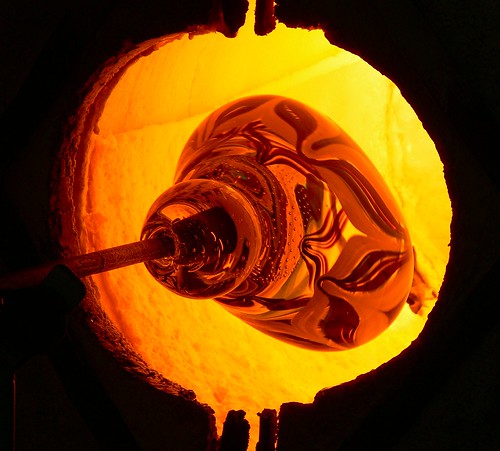
Imagine~. That building is your own house. Beautiful environment, nice building appearance, blueish sky, greenish floor, transparent wall. WOW!! Its marvellous!! (But your daily life will be exposed to outside?? even when you pee-ing and shitting?? *_* )
Sold Price: RM10,000,000.00/=
For more detail, please contact Mr.Shawn.
Limited Edition
Availabe For TODAY only. (6 June 2009)
Just kidding. The building is related to what i want to talk about for today. Do you see the my topic within the picture? No? Yes? Haha. Then see the following picture.

Do you see any similarities between both picture? Yes!! Thats right. If u spot it, then that is my topic of this post.
 Yeap!! The topic is GLASS. What is glass? How it made? What chemical composition inside it? How many types of glass there on the earth? Those answer will be revealed within the post. We use glass to drink beer, red wine, orange juice, and water.
Yeap!! The topic is GLASS. What is glass? How it made? What chemical composition inside it? How many types of glass there on the earth? Those answer will be revealed within the post. We use glass to drink beer, red wine, orange juice, and water.Lets starts with the characteristic of Glass:
- solid and hard material.
- Fragile and easily breakable into sharp piece.
- Transparent.
- amorphous structure.
- 100% recycable.
- inert material.
- does not rust, corrode, deteriorate, stain.
- application on architecture, laboratory apparatus, optical instrument, and etc.
- Able to become a deadly weapon.
Now, What actually make the glass? What ingredient inside it? The glass is composed by three common ingredient.the sand will melts. Adding soda will lower the melting point of the sand to 1000 where the sand is more manageable
- Sand (SiO2 silica) - It exist as polymer in its pure state.
- Soda Ash ( sodium carbonate Na2CO3) - At 2000°C the sand will melts. Adding soda will lower the melting point of the sand to 1000°C where the sand is more manageable.
- Limestone ( calcium carbonate CaCO3) or dolomite ( MgCO3) - Addition of soda causes the glass to be water-soluble, soft and not durable. Hence, limestone is added to increase the hardness of the glass, chemical durability and providing insolubility of the material.
There are several steps to transform the sand into transparent and beautiful glass.
- Mixing
- Melting
- Forming
- Cooling
In mixing state, the glass ingredient is mixed. The mix ingredient is called batch. Some cullet is added to the batch. Cullet is either the recycled glass or the waste glass from previous melt of the same kind. This will able to save on some amount of batch and adding the cullet will reduce the heat needed to melt the batch as the cullet had been melted from previous heating instead of the batch.
The batch is then added to a furnace for melting it. At arund 1500°C, the batch will melts.
After the desired shape is formed, the glass is left for cooling. The cooling state make the glass hard, fragile, and inert.
There are several types of Glass:
1. Soda Lime Glass or Commercial glass -
- composed of 60%-75% silica, 12%-18% soda and 5%-12% lime.
- has light transmission and often used for flat glass in window.
- smooth and nonporous surface enable the glass bottle to be easily cleaned.
- resistant to chemical attack.
- does not absorb UV light.
- not resistant to high temperature. (will break when in contact with high temperature liquid)
- example : window glass, drinking glass and etc.
2. Lead Glass -
- composed of 54%-65% silica, 18%-38% Lead Oxide (PbO), 13%-15% soda or potash(K2) and various oxide.
- moderate amount of lead increase the durability of glass
- High amount of lead lowers the melting point and decrease the hardness giving a soft surface for the glass.
- High refractive index.
- glass with high lead oxide composition is able to used as radiation shielding glass as lead absorb gamma ray and other harmful radiation before the radiation penetrate the glass.
- Mostly used in nuclear industry.
- Unable to withstand high temperature and sudden change of temperature.
3. Borosillicate Glass -
- composed of 70%-80% silica, 7%-13% Boric oxide (B2O3), 4%-8% of sodium oxide(Na2O and potassium oxide (K2O) and 2%-7% or aluminium oxide (Al2O3)
- Greater resistance to temperature change and chemical corrosion
- Used in laboratory, chemical processing plant, and etc.
- greater resistant to thermal shock and increase the accuracy in laboratory experiment.
There are others material that added to the glass to form other special glass:
- Alumina - increase chemical resistance and vicosity in lower temperature change.
- Cerium - Absorb the infrared ray.
- Barium oxide - provide high refractive index.
- Fluorine - provide a cloudy and opaque impression.
A beautiful and artistic glass is formed.
The glass is now ready to be used for drinking red wine.
For more detail about red wine, please refer to --> Click Here




